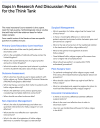The Inaugural UK National Hallux Valgus Think Tank : identification of key issues and strategies to improve clinical care for patient benefit
- PMID: 40222731
- PMCID: PMC11994245
- DOI: 10.1302/2633-1462.64.BJO-2024-0212.R1
The Inaugural UK National Hallux Valgus Think Tank : identification of key issues and strategies to improve clinical care for patient benefit
Abstract
Aims: Hallux valgus (also known as a bunion) is a common forefoot deformity impacting pain, function, quality of life, and mobility, with higher prevalence in females and increasing incidence with age. The high prevalence and rates of surgical treatment potentially have a major impact on the healthcare system. The aim of this stakeholder consultation was to identify current issues with provision of hallux valgus treatment, as well as identify achievable goals to improve understanding of hallux valgus and guide future assessment, treatment pathways, and research directions with the aim of improving clinical outcomes for patients.
Methods: Scoping searches were undertaken to inform and identify relevant outcome sets and existing evidence relating to hallux valgus. A one-day think tank conference was held on 21 June 2024, involving stakeholders from various sectors, including patients, primary and secondary care professionals, researchers, and representatives of national societies. Key themes and issues related to hallux valgus were identified and used to develop structured action development plans.
Results: Major issues identified include the absence of national policy recommendations, variability in treatment pathways, and gaps in research and patient education. Patient experiences highlighted the significant impact on quality of life and the need for standardized information and care pathways. Key priorities for research include developing a core outcome set and understanding the patient's lived experience, while policy priorities focus on creating national guidelines and raising awareness of the condition's socioeconomic and functional impacts.
Conclusion: The inaugural UK National Hallux Valgus Think Tank identified critical issues in the management of hallux valgus and developed strategies to improve clinical outcomes through research and policy development. Establishing a working group and prioritizing both research and policy initiatives will be essential to advancing the understanding and treatment of hallux valgus.
© 2025 Lewis et al.
Conflict of interest statement
M. Thomas and A. Angadji are employees of Orthopaedic Research UK. T. Lewis reports royalties or licenses and consulting fees from Vilex, which are unrelated. J. Mangwani declares royalties or licenses from Meshworks, and consulting fees from MeshWorks and Orthosolutions; and is Caldicott Guardian for British Orthopaedic Foot and Ankle Society, all of which are also unrelated to this work. A. See reports a AOUK&I major research grant, which is also unrelated. S. O’Neill discloses unrelated grants or contracts from Expanding Excellence in England, Private Physiotherapy Education Fund, British Association of Sports and Exercise Medicine, and ERC (UK Research and Innovation) funding for IAA.
Figures
References
-
- Roddy E. Epidemiology and impact of hallux valgus: more than just bunions. J Foot Ankle Res. 2011;4(S1):A8. doi: 10.1186/1757-1146-4-S1-A8. - DOI
Grants and funding
LinkOut - more resources
Full Text Sources




